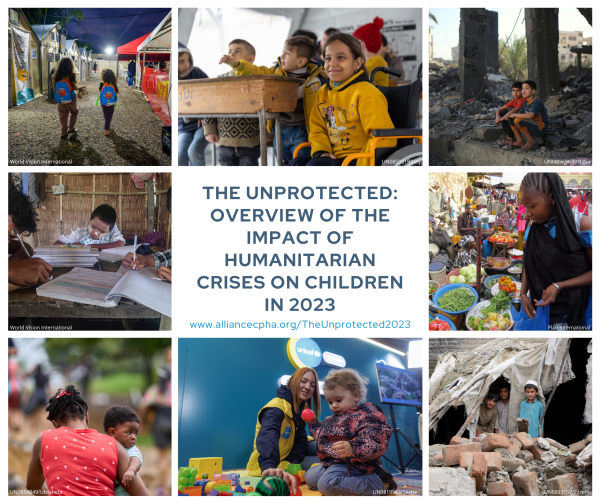
The Unprotected: Overview and Technical Annex on the Impact of Humanitarian Crises on Children in 2023

Explore the Dedicated Webpage here!
As we reflect on 2023 and embark on a new year, the Alliance is deeply concerned about the devastating consequences of increasing armed conflict, climate-induced emergencies, and disasters associated with natural hazards on children around the world.
In 2023, the violation of International Humanitarian Law (IHL) and International Human Rights Law (IHRL) reached alarming levels, leaving one in five children globally living in or fleeing conflict zones. The toll on children is alarming, with increased recruitment, maiming, and killing by armed forces, along with abductions and sexual violence. Armed groups exploit essential services, attacking hospitals and schools, while life-saving humanitarian aid is deliberately denied. The impact on children's physical, emotional, and mental health is profound, with lifelong consequences if left unaddressed.
The UN Secretary General's 2023 report on Children and Armed Conflict revealed record-breaking numbers of grave violations against children. Situations with the highest numbers of children affected were the Democratic Republic of the Congo, Israel and the State of Palestine, Somalia, Ukraine, and Syria. Attacks on schools and hospitals surged, and child recruitment increased, painting a grim picture. The current conflict in Gaza stands out as the deadliest for children, necessitating an immediate ceasefire to avert a humanitarian catastrophe.
Children have the right to a safe and healthy environment, yet the climate crisis continues unabated. Devastating earthquakes in Syria, Afghanistan, Türkiye, and Morocco have exacted an enormous toll on children and their families, straining social protection mechanisms already weakened by previous crises. Economic vulnerability exacerbates child protection risks, such as trafficking, child labour, psychosocial distress, child marriage, family separation, and recruitment and use by armed forces and armed groups, with funding shortfalls leading to cuts in vital assistance.
As more and more people are forced to flee situations of conflict, violence, and climate-induced disasters, the number of forcibly displaced people reached another record high in 2023 and is now over 114 million people. Children affected by forced displacement and statelessness face heightened risks of violence, neglect, abuse, and exploitation.
Amidst these crises, the Alliance calls for urgent action and investment in three critical areas in 2024:
- Invest in the Child Protection Workforce — it is the key asset to protect children in crises
- Prioritise preventing harm while continuing the response to urgent needs
- Join us - Every actor across the humanitarian system has a role to play in protecting children
As we look ahead to 2024 and beyond it is imperative that children’s rights are protected as a priority, before, during, and post conflict and crises. Detailed recommendations for action can be found in the Technical Annex, underscoring the urgency of addressing these critical issues.
About the Overview and Technical Annex: This Overview and its Technical Annex were developed by the Alliance for Child Protection in Humanitarian Action. We would like to thank the following Alliance members and partners for their expert contributions and guidance: The Global Child Protection Area of Responsibility, the International Federation of the Red Cross, the Inter-agency Network for Education in Emergencies, the Office of the Special Representative of the Secretary-General for Children in Armed Conflict, International Rescue Committee, Street Child, Save the Children, World Vision International, and Watchlist. The Thematic Spotlights and the Areas for Action were identified based upon consultations with country-based teams from Alliance member organisations and child protection coordination groups across 13 humanitarian contexts.
- 208 views
